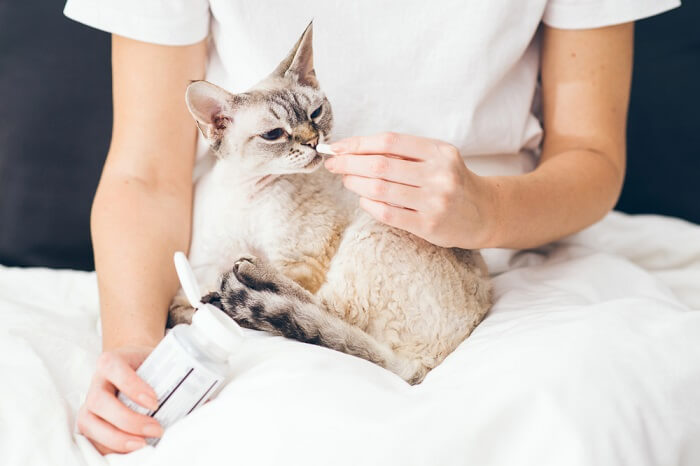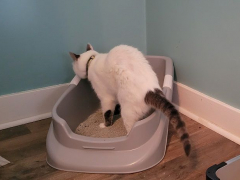
This article aims to explain the details of atopic dermatitis (atopy) in cats. The aim of this article is to provide a simple, clear explanation about this common allergic skin disease for pet owners.
Quick Overview: Atopic Dermatitis In Cats







What Is Atopic Dermatitis?
Atopic dermatitis is an itchy skin condition seen in cats (and in other small animals like dogs), caused by inflammation that follows an allergic reaction to environmental allergens.
How Common Is Atopic Dermatitis?
This type of allergic dermatitis is a common problem, affecting around one in eight of the cats that are referred for work ups to veterinarians specialising in veterinary dermatology.
How Do Cats Get Atopic Dermatitis?
Affected cats may have a genetic predisposition to develop this allergy-based condition, but in most cases, there are no known specific causes, and it is not more common in some breeds than others.
Symptoms of Atopic Dermatitis in Cats

Most common symptoms of atopic dermatitis in cats usually include itchiness, licking the feet, ear infections and skin infections.
Clinical signs associated with atopic dermatitis include:
- Pruritus (itchiness, with scratching all over, licking the feet, etc)
- Otitis externa (ear infections)
- Recurrent skin lesions and skin infections (pyoderma)
- Alopecia (baldness)
- Miliary dermatitis (roughened patches of scabby skin)
- Eosinophilic granuloma (raised areas of pink, sore-looking skin also known as eosinophilic plaques)
Causes of Atopic Dermatitis in Cats
This is an immune-mediated disease (a disease of the immune system), with affected cats seeming to have a genetic predisposition to developing hypersensitivity to allergens in their environment.
Diagnosis of Atopic Dermatitis
If your DVM veterinarian suspects that your cat may have atopic dermatitis, the following steps may be taken.
Detailed History Taking
Your vet will discuss every aspect of your cat’s life and health care. There are other causes of the same types of signs as atopic dermatitis, and this history will help to differentiate the various possible causes.
Sometimes the itchiness has a seasonal pattern (e.g. if an allergy to a plant in flower is the cause) but often it happens all year round, and sometimes it may be seasonal at first, progressing to all-year-round over time.
Physical Examination
Your veterinarian will check your cat over carefully, noting the precise nature and pattern of the lesions in the itchy skin. Reddened areas (erythema), nettle-sting-like rashes (papules and wheals) and excoriations (areas of self-damage by scratching) may be seen.
Affected areas include the armpits (axillae) groin (inguinal area), under the tail (perianal), around the eyes (periocular), around the mouth (perioral) as well as the ears and head.
Skin Tests
Your veterinarian may suggest a number of skin tests to investigate the problem. Some primary veterinarians my prefer to refer you to a vet with a particular interest in dermatology (a veterinary dermatologist) for some or all of this work up to be done.
1. Fungal Culture
Ringworm (dermatophytosis) may need to be ruled out by culturing skin and fur samples.
2. Skin Scrapings And Cytology
Itchiness is commonly caused by parasites such as flea allergy, lice, demodex, notoedres and others, so these need to be ruled out. Bacteria/ yeast secondary infections need to be identified too n case they are aggravating an underlying allergy.
3. Allergy Testing
Two types may be used.
- Intradermal Allergy Test (IDT): IDT may be used to identify which allergens may be causing this problem, and this allows the selection of allergens for allergen-specific immunotherapy (ASIT) or to identify allergens so that they can be avoided.
- Serologic Allergy Test (SAT): involves using a blood sample to identify the offending allergens by measuring antibody (IgE) levels.
4. Skin Biopsy
A skin biopsy does not reveal specific changes that allow the direct diagnosis of feline atopic dermatitis, but histopathology of a sample of skin does allow the ruling out of other differential diagnoses.
5. Response to Therapy:
A simple and logical process of ruling out other causes of itchy skin can play an important role in diagnosing feline atopic dermatitis.
- A food trial (giving only a special diet for 6 – 8 weeks) can be useful to rule out food allergy.
- Thorough parasite treatments (e.g. implementing thorough flea control) are often needed to completely rule out skin parasites.
- A response to trial treatment with anti-inflammatory medication can confirm the likelihood of atopic dermatitis.
How Much Does It Cost To Treat a Cat With Atopic Dermatitis?
The cost depends on many factors of individual cases. You should ask your veterinarian for a detailed estimate before agreeing to proceed with treatment. Typically it may cost $400 to $800 to carry out an initial work up, then $30 to $100 per month for ongoing care.
Treatment for Atopic Dermatitis

Treatment options usually include corticosteroids or glucocorticoids, antihistamines, EFA supplements, calcineurin inhibitors and shampoos.
There are a number of treatment options.
- The cornerstone of treatment has been corticosteroids or glucocorticoids, with oral prednisolone being commonly used, aiming at the lowest possible dose, perhaps given on alternate days, as needed to control the problem. Long-acting depot glucocorticoid injections are a useful alternative for cats that are difficult to medicate.
- Antihistamines are not strong enough to control established signs, but may be helpful at a later stage to prevent flare ups.
- Essential fatty acid (EFA) supplements may help in the long term by optimising skin health and so reducing the dose needed of stronger medication like corticosteroids.
- Calcineurin inhibitors such as cyclosporine (“Atopica”) and tacrolimus are immune system modulators which may be useful as part of long term treatment.
- Other more recently developed anti-inflammatory medication like Oclacitinib (“Apoquel”) may not yet be licensed for cats, but may be recommended by veterinarians for certain cases.
- Shampoos and baths may help some cases (e.g. specific medicated baths if malassezia infection is aggravating the itchiness).
- Immunotherapy: Allergen-specific immunotherapy (ASIT) may be used to reduce the need for stronger systemic, immunomodulating medications. ASIT works through a process known as hyposensitization. Causative allergens or antigens are first identified by intradermal allergy tests (IDT) or blood tests (SAT). These allergens can then be incorporated into a custom-made sterile formulation. This can be given in gradually increasing doses by subcutaneous injection or by sublingual drops, and it may be effective in around 60% of cases. The idea is that the cat’s immune system is gradually familiarised with the allergens, and so becomes less likely to react in an exaggerated way which is what produces the itchiness.
- Allergen avoidance may be possible in some cases (e.g. removing fabrics, avoiding specific vegetation etc).
Monitoring and Prognosis
Since the main sign of atopic dermatitis is itchiness, it is generally simple for owners to monitor this disease, although regular veterinary check ups are helpful. Most cases respond well to treatment although long term, ongoing medication is usually needed.
Conclusion
Atopic dermatitis is a type of allergic skin disease causing itchiness and skin rashes in cats. It often needs lifelong management with ongoing medication under veterinary supervision.







